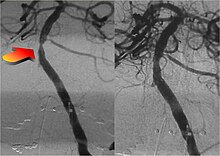Interventional neuroradiology
Interventional neuroradiology (INR) also known as neurointerventional surgery (NIS), endovascular therapy (EVT), endovascular neurosurgery, and interventional neurology is a medical subspecialty of neurosurgery, neuroradiology, intervention radiology and neurology specializing in minimally invasive image-based technologies and procedures used in diagnosis and treatment of diseases of the head, neck, and spine.[1]
History

Diagnostic angiography
Subsequently, European radiologists further developed the angiographic technique by replacing the traumatic direct puncture with catheterization: in 1953, Swedish physician Sven Seldinger introduced the technique of arterial and venous catheterization still in practice,[4] dubbed the Seldinger Technique. In 1964, the Norwegian radiologist Per Amudsen was the first to perform a complete brain angiography with a transfemoral approach, as it is performed today; he then moved to San Francisco to teach the technique to American neuroradiologists.[5] These two stages, at the basis of modern invasive vascular diagnostics, prepared the way for later therapeutic developments.
The first treatments: balloon occlusion
The first to carry out a true endovascular procedure was Charles Dotter, the father of angioplasty and considered by many as the father of all interventional radiology, as well as the first doctor to have performed endovascular treatment. On January 16, 1964, he performed a therapeutic angioplasty of a superficial femoral artery in an 82-year-old woman with an ischemic leg refusing amputation.[6] The artery remained open for the next two and a half years, after which the woman died of pneumonia.
The concept of using balloons to treat cerebrovascular lesions was inspired by a 1959 May Day celebration in Moscow’s Red Square. While watching children use tether lines to manipulate helium balloons, Fedor Serbinenko, a Russian neurosurgeon, began to envision small balloons moving through tortuous arteries.[7] In the 1970s Fedor Serbinenko developed a technique for closing intracranial aneurysms with balloons that were released into the internal carotid artery by occluding the lumen. The first treatment was performed in 1970 in Moscow, with the occlusion of an internal carotid to treat a carotid-cavernous fistula. He can be considered, therefore, the first interventional neuroradiologist. This technique was subsequently refined by neuroradiologists all over the world and mainly in France, where interventional neuroradiology developed and flourished.
Parallel to the development of catheters, in the radiology and neuroradiology units, image technology dramatically improved: Charles Mistretta in 1979 invented digital subtraction angiography (DSA), the technique currently in use. It consists of performing skull radiography under basic conditions which are then "subtracted" to the image after contrast media injection, to provide an image where only brain vessels are displayed, with great improvement in the diagnostic potential.
Coils replace balloon occlusion
Between the end of the 1980s and the beginning of the '90s, INR was suddenly revolutionized after the work of two Italian physicians:
New techniques: Sole stenting and flow diversion stents
From the early 2000s, intracranial stents were used to prevent the coils inside the aneurysmal sac from protruding into the parent artery.[11][12] Flow diversion devices were later developed, with the function of reconstructing the vessel's normal anatomy without directly closing the aneurysm neck and therefore preserving side branches and preventing ischemia.[13] The sole stenting[14] procedure involves the insertion of a stent only (without any coils) into the vessel that has an aneurysm.[15]
Not just hemorrhages: the treatment of ischemic stroke
The Souers Stroke Institute was founded in 1991 at Saint Louis University, and its first director, Camilo R. Gomez, M.D., is often credited with founding interventional neurology as a subspecialty in the United States.[16]
Between January and June 2015, five major randomized trials were published in the New England Journal of Medicine (NEJM) with the collaboration of interventional neuroradiologists and stroke neurologists (in the Netherlands,[17] Canada,[18] Australia,[19] US[20] and Spain[21]) regarding the role of mechanical thrombectomy in the treatment of ischemic stroke, demonstrating that if it is performed in centers with proven experience, intra-arterial mechanical thrombectomy is more effective than traditional treatment (intravenous thrombolytic injection). The promising results of these mechanical thrombectomy trials were highlighted by the NEJM in an editorial, which concluded with the statement: "Endovascular equipoise no longer exists. It's about time."[22]
Thrombectomy is currently recommended by the guidelines written by the main American (AHA/ASA)[23] and European (ESO-ESNR-ESMINT)[24] societies of stroke neurologists and interventional neuroradiologists.
Diseases and conditions

The following is a list of diseases and conditions typically treated by neurointerventionalists.
- Cerebral aneurysm
- Brain arteriovenous malformation (AVM)
- Carotid-cavernous fistula (CCF)
- Dural arteriovenous fistula
- Extracranial (brachiocephalic) atherosclerosis
- Extracranial (head and neck) and paraspinal vascular malformations
- Head and neck tumors
- Intracranial atherosclerosis
- Juvenile nasopharyngeal tumor
- Meningiomas
- Nosebleeds
- Paragangliomas
- Stroke
- Spinal vascular malformations
- Traumatic vascular lesions
- Vasospasm
- Vertebral body tumors
- Vertebral body compression fractures
See also
References
- S2CID 26791160.
- PMID 22622317.
- PMID 28974927.
- PMID 13057644.
- PMID 11237988.
- PMID 24557558.
- PMID 24402485.
- ^ ISBN 9781135583330.
- S2CID 30623125.
- S2CID 30220296.
- PMID 10626961.
- S2CID 24343785.
- PMID 25624975.
- PMID 20175900.
- S2CID 41571535.
- ^ "Neurology Fellowships".
- S2CID 9499117.
- PMID 25671798.
- S2CID 4688893.
- PMID 25882376.
- PMID 25882510.
- PMID 25882509.
- S2CID 4972922.
- PMID 29478797.
